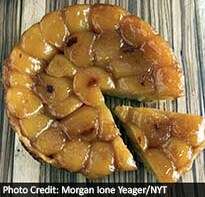Apple pie is not easy. I have executed lovely crusts folded around inedible sour fillings, perfect fruit sandwiched between a pale bottom crust and a burned lattice top, and most other permutations of pie fail. At the risk of seeming unpatriotic, I would even say that a good pie is not the single best thing you can make with fall's most plentiful and alluring fruit.
The apple pieces are arranged like flower petals in this sturdy, sugary base, which helps keep them standing upright. Then they are snugged together under a blanket of (store-bought) puff pastry, and the heat of the stovetop begins the cooking process. The apples become caramelized - simmered in toasted sugar, melted butter and their own juices - but without any tending or testing by the cook. The sugar mixture will continue to brown while the tart is in the oven, so in the first step the color should be only a warm golden brown."You don't want French black," he said, sounding like a jaded fashion critic, but in reference to the dark, almost-but-not-quite-burned sugar solution required for desserts like crème caramel.
Avoid failed flips by using a heavyweight nonstick pan or a very well-seasoned cast-iron skillet. Don't wait more than five minutes to turn the tart out. The longer it cools in the pan, the more likely it is to stick.And if the worst happens midflip, the tart will be delicious anyway; gently scrape the apples out of the pan and reassemble them on the pastry. The result will not win any prizes for food styling, but the taste will be the same.Recipe: Foolproof Tarte Tatin
Adapted from Ron Paprocki, Gotham Bar & Grill
Time: 1 1/2 hours, plus 1 to 2 days' aging time for apples
Yield: 8 servings
6 to 8 large, firm-fleshed apples, preferably Braeburn, or use a mix of Honeycrisp and Granny Smith
6 tablespoons/80 grams salted butter, very soft
2/3 cup/135 grams granulated or light brown sugar
1 sheet all-butter puff pastry, about 8 ounces (store-bought is fine)1. At least one day before you plan to cook the tart, prepare the apples: Slice off the bottom of each apple so it has a flat base. Peel and quarter the apples. Use a small sharp knife to trim the hard cores and seeds from the center of each quarter; don't worry about being too neat. Transfer to a bowl and refrigerate, lightly covered, for at least one day or up to three days. (This key step reduces the liquid in the tart. Don't worry if the apples turn brown; they will be browned during the cooking anyway.)
Advertisement
Advertisement
The apple pieces are arranged like flower petals in this sturdy, sugary base, which helps keep them standing upright. Then they are snugged together under a blanket of (store-bought) puff pastry, and the heat of the stovetop begins the cooking process. The apples become caramelized - simmered in toasted sugar, melted butter and their own juices - but without any tending or testing by the cook. The sugar mixture will continue to brown while the tart is in the oven, so in the first step the color should be only a warm golden brown."You don't want French black," he said, sounding like a jaded fashion critic, but in reference to the dark, almost-but-not-quite-burned sugar solution required for desserts like crème caramel.
Avoid failed flips by using a heavyweight nonstick pan or a very well-seasoned cast-iron skillet. Don't wait more than five minutes to turn the tart out. The longer it cools in the pan, the more likely it is to stick.And if the worst happens midflip, the tart will be delicious anyway; gently scrape the apples out of the pan and reassemble them on the pastry. The result will not win any prizes for food styling, but the taste will be the same.
Advertisement
Adapted from Ron Paprocki, Gotham Bar & Grill
Time: 1 1/2 hours, plus 1 to 2 days' aging time for apples
Yield: 8 servings
6 to 8 large, firm-fleshed apples, preferably Braeburn, or use a mix of Honeycrisp and Granny Smith
6 tablespoons/80 grams salted butter, very soft
2/3 cup/135 grams granulated or light brown sugar
1 sheet all-butter puff pastry, about 8 ounces (store-bought is fine)1. At least one day before you plan to cook the tart, prepare the apples: Slice off the bottom of each apple so it has a flat base. Peel and quarter the apples. Use a small sharp knife to trim the hard cores and seeds from the center of each quarter; don't worry about being too neat. Transfer to a bowl and refrigerate, lightly covered, for at least one day or up to three days. (This key step reduces the liquid in the tart. Don't worry if the apples turn brown; they will be browned during the cooking anyway.)
Advertisement
For the latest food news, health tips and recipes, like us on Facebook or follow us on Twitter and YouTube.
Advertisement
